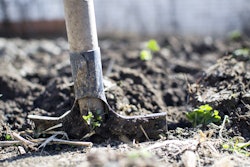 Photo: Ditch Witch
Photo: Ditch WitchEvery landscaper wants to reduce downtime as much as possible and one way to help with this is to practice proper routine maintenance on your trenching machines.
By being proactive, you can work to prevent problems from occurring in the field when your operators are working, saving both time and money. An added bonus of having a solid maintenance program is it extends the life of the machine as well.
As manufacturers continue to reduce the amount of maintenance that is required for their machines, landscapers can forget the importance of doing a daily walk around before using their trencher.
“Overall, as far as a daily maintenance we suggest a walk around of the machine,” says Chris Thompson, a product manager of compact equipment for Ditch Witch. “Make sure all your service points are where they should be before starting. Make sure your chain’s tight. Make sure the machine’s clean before you start using it. Those little things can make a big difference on the productivity of your job.”
While your owner’s manual is the ultimate guide for specific maintenance recommendations and needs for your equipment, below are some common elements to check on when taking care of your trencher.
Digging teeth, chains, sprockets
One of the most commonly overlooked elements of trencher maintenance is not replacing digging teeth often enough.
“Just because the trencher is digging doesn’t mean that it’s digging optimally and ensuring your teeth have good life left on them is important,” says Tyler Schwandt, a product manager of chain teeth and sprockets with Ditch Witch.
Digging teeth should be visually inspected before each job or after every 10 hours of operation. Once the hardfacing on the teeth have worn away, it’s important to replace them. Dull teeth will increase the shock load to other trencher components.
“They’re less efficient when they’re digging and operating the piece of equipment, and it can lead to increased wear on other parts through increased vibration from the chain if the digging teeth aren’t kept up,” Schwandt says.
The proper chain tension for your trencher may vary, but Schwandt says for Ditch Witch trenchers, a correctly tensioned digging chain is 1.5 to 2 inches at the lowest point of the boom horizontal, or roughly two fingers, if you’re trying to get an estimate.
Over-tightening the digging chain can result in chain stretch and loss of machine performance, while a chain that is too loose can slip off the sprockets.
When it comes time to replace the chain or the sprockets, be sure to replace both at the same time.
“To replace those at the same time will increase the life of each of those components,” Schwandt says. “If you replace one and not the other, the newer component will wear faster, so it just allows you to maintain your equipment better and keep those new items working better for longer.”
Oil and other fluids
 Photo: Ditch Witch
Photo: Ditch WitchOne of the consistent requirements for trencher maintenance is to change the engine oil. For example, the C12, C14 and C16 walk-behind Ditch Witch trencher’s manual calls for engine oil changes after the first 10 and 20 hours of operation and every 100 hours after. The manual also says the engine oil and filter should be changed every 50 hours and every 100 hours.
Oil changes help ensure a long engine life, so it is important to make sure you are using quality oil for your machine.
As for other fluids, monitoring and maintaining the correct levels helps prevent premature damage to internal gears. Follow the recommendations outlined in your operator’s manual to meet the proper fluid requirements.
Lubrication
The need for greasing is less common, depending on the type of trencher you are using, but greasing is still an important maintenance task for the grease points that remain.
It is better to grease lightly and frequently than to use too much grease on a less frequent basis.
“On our trenchers we’ve gone to sealed bearings on a lot of our pivot points because it is extremely important to have that proper lubrication and what we find is rather than counting on people to actually do that,” Thompson says. “If we can go to some kind of sealed bearing that will maintain that proper lubrication for us without someone having to think about it that tends to help.”
Consider the work environment
Chain and tooth configurations should be matched to the digging conditions. The owner’s manual will outline which type of chains work the best in each type of soil as no one chain works well in all conditions.
It’s also important to understand that certain environments will accelerate the need for maintenance.
“Any time you get into a sandy soil, sand can cause a lot of friction and grinding on parts so sand can be a problem,” Thompson says. “Also, anytime you get into something that’s sticky, muddy, anything that’s going to cause that ground to be on the trencher and cause clogging can be a problem.”









